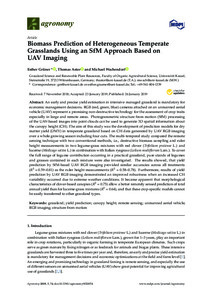Biomass Prediction of Heterogeneous Temperate Grasslands Using an SfM Approach Based on UAV Imaging
| dc.date.accessioned | 2019-02-05T11:59:13Z | |
| dc.date.available | 2019-02-05T11:59:13Z | |
| dc.date.issued | 2019-01-26 | |
| dc.identifier | doi:10.17170/kobra-20190204158 | |
| dc.identifier.uri | http://hdl.handle.net/123456789/11059 | |
| dc.description.sponsorship | Gefördert durch den Publikationsfonds der Universität Kassel | ger |
| dc.language.iso | eng | |
| dc.rights | Urheberrechtlich geschützt | |
| dc.rights.uri | https://rightsstatements.org/page/InC/1.0/ | |
| dc.subject | grassland | eng |
| dc.subject | yield prediction | eng |
| dc.subject | canopy height | eng |
| dc.subject | remote sensing | eng |
| dc.subject | unmanned aerial vehicle | eng |
| dc.subject | RGB imaging | eng |
| dc.subject | structure from motion | eng |
| dc.subject.ddc | 630 | |
| dc.title | Biomass Prediction of Heterogeneous Temperate Grasslands Using an SfM Approach Based on UAV Imaging | eng |
| dc.type | Aufsatz | |
| dcterms.abstract | An early and precise yield estimation in intensive managed grassland is mandatory for economic management decisions. RGB (red, green, blue) cameras attached on an unmanned aerial vehicle (UAV) represent a promising non-destructive technology for the assessment of crop traits especially in large and remote areas. Photogrammetric structure from motion (SfM) processing of the UAV-based images into point clouds can be used to generate 3D spatial information about the canopy height (CH). The aim of this study was the development of prediction models for dry matter yield (DMY) in temperate grassland based on CH data generated by UAV RGB imaging over a whole growing season including four cuts. The multi-temporal study compared the remote sensing technique with two conventional methods, i.e., destructive biomass sampling and ruler height measurements in two legume-grass mixtures with red clover (Trifolium pratense L.) and lucerne (Medicago sativa L.) in combination with Italian ryegrass (Lolium multiflorum Lam.). To cover the full range of legume contribution occurring in a practical grassland, pure stands of legumes and grasses contained in each mixture were also investigated. The results showed, that yield prediction by SfM-based UAV RGB imaging provided similar accuracies across all treatments (R^2 = 0.59–0.81) as the ruler height measurements (R^2 = 0.58–0.78). Furthermore, results of yield prediction by UAV RGB imaging demonstrated an improved robustness when an increased CH variability occurred due to extreme weather conditions. It became apparent that morphological characteristics of clover-based canopies (R^2 = 0.75) allow a better remotely sensed prediction of total annual yield than for lucerne-grass mixtures (R^2 = 0.64), and that these crop-specific models cannot be easily transferred to other grassland types | eng |
| dcterms.accessRights | open access | ger |
| dcterms.creator | Grüner, Esther | |
| dcterms.creator | Astor, Thomas | |
| dcterms.creator | Wachendorf, Michael | |
| dc.relation.doi | doi:10.3390/agronomy9020054 | |
| dc.type.version | publishedVersion | |
| dcterms.source.identifier | EISSN: 2073-4395 | |
| dcterms.source.issue | 2 | |
| dcterms.source.journal | Agronomy | eng |
| dcterms.source.pageinfo | 54 | |
| dcterms.source.volume | 2019, 9 |
Dateien zu dieser Ressource
Das Dokument erscheint in:
-
Artikel [1179]

